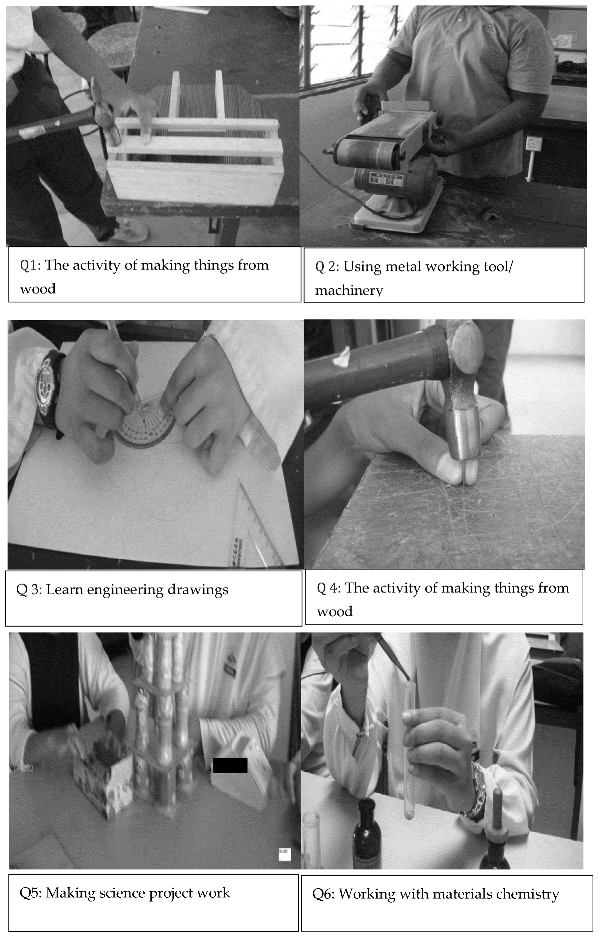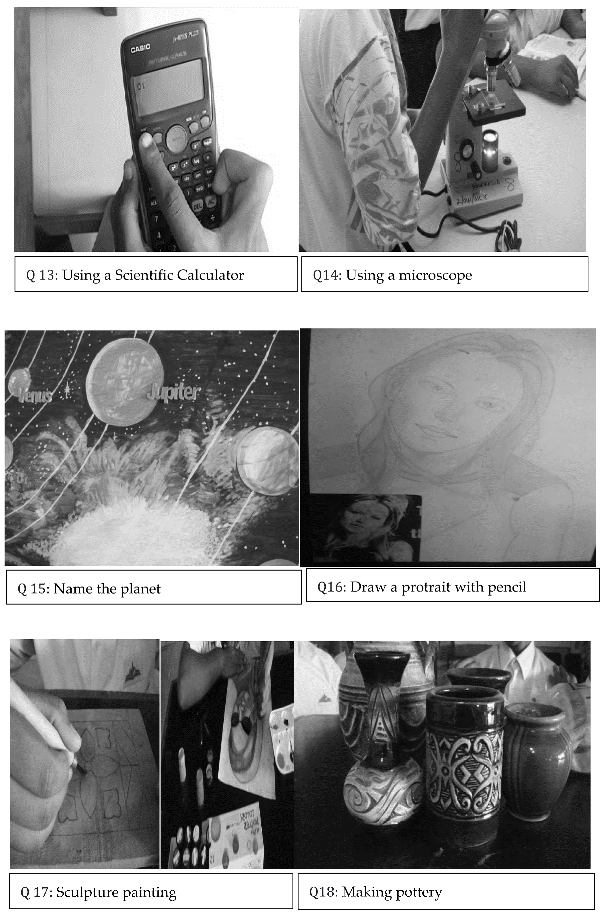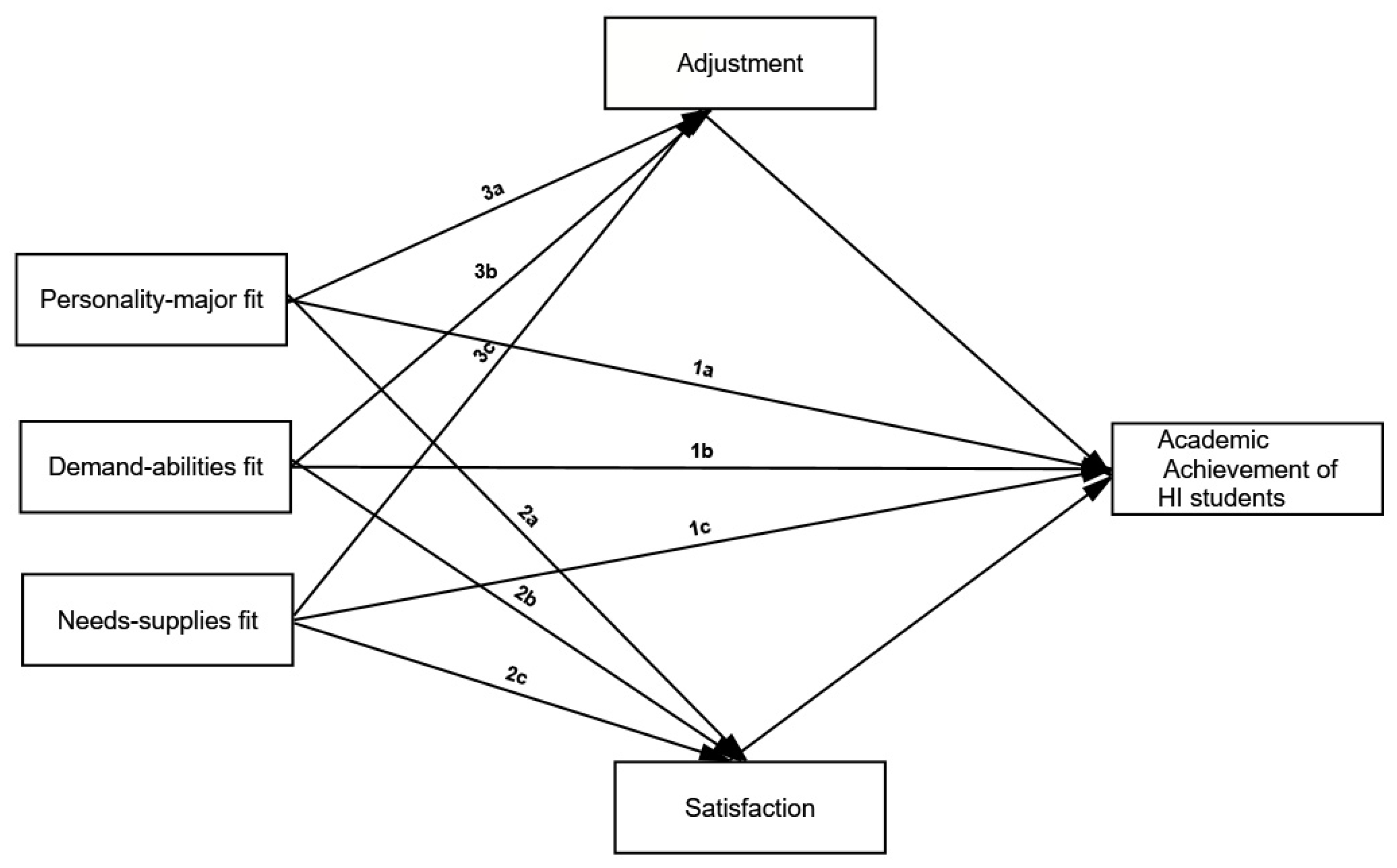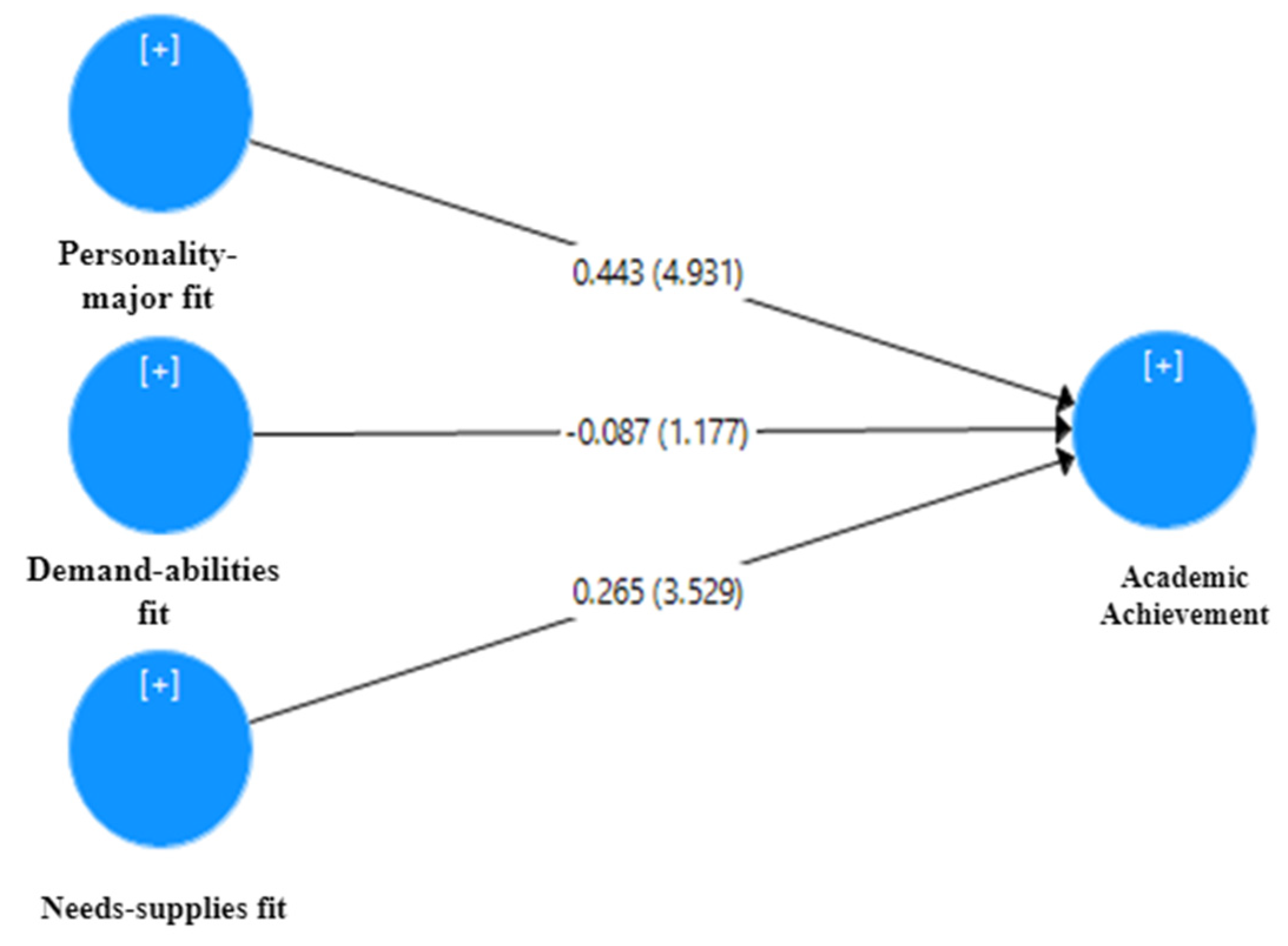Does a Person-Environment-Fit Promote the Academic Achievement of Hearing-Impaired Students in Malaysian Polytechnics? The Mediating Effects of Satisfaction and Adjustment
Abstract
:1. Introduction
Rationale of the Study
2. Literature Review
2.1. Person-Environment (P-E) Fit Theory
2.2. The Person-Environment (P-E) Fit—Academic Achievement Relationship
2.3. The Person-Environment (P-E) Fit in Relation to Satisfaction and Academic Achievement
2.4. The Person-Environment (P-E) Fit in Relation to Adjustment and Academic Achievement
3. Methodology
3.1. Participants and Procedure
3.2. Measures
3.3. Data Analyses
4. Results
4.1. Preliminary Analysis
4.2. Hypothesis Testing
4.2.1. Structural Model
4.2.2. Mediation Tests of Student Adjustment and Satisfaction
5. Discussion and Implications
6. Limitations and Future Research Directions
7. Conclusions
Author Contributions
Funding
Institutional Review Board Statement
Informed Consent Statement
Conflicts of Interest
Appendix A
| Construct | Measurement Item |
|---|---|
| Student satisfaction | I feel satisfied to choose this field of study. |
| I have no desire to change my field. | |
| I am passionate about this field. | |
| I am interested in this field. | |
| I feel satisfied with the learning activities in the classroom. | |
| I feel satisfied with the manner in which the instructors teach. | |
| I feel satisfied because the instructor is proficient in sign language. | |
| I feel satisfied because the instructor does not treat me differently. | |
| I feel satisfied with the co-curricular activities at the polytechnic. | |
| I feel satisfied with the peer coaching activities at the polytechnic. | |
| I feel satisfied with classroom support services such as sign language interpretation. | |
| I feel satisfied with the help by friends in the classroom. | |
| I feel satisfied with the OKU-friendly facilities (e.g., washroom condition, rooms, cafeteria). | |
| I feel satisfied with the learning facilities at the Polytechnic. | |
| Adjustment | I make good friends with my classmates. |
| I have a good relationship with my instructor. | |
| I participate actively in group discussions. | |
| I participate in all of the activities planned by the Special Skills Certificate instructors. | |
| I keep track of the activities at the polytechnic. | |
| I keep track of the Polytechnic’s activities with friends, without hearing impairments. | |
| I participate regularly in extra-curricular activities. | |
| I do not have difficulty in interactioning with my classmates. | |
| I am not alone at the Polytechnic. | |
| I make friends who do not have hearing impairments. | |
| My instructor is someone I can count on to assist me. | |
| I seek the help of the Student Counseling Unit when confronted with a problem. | |
| I have a good sense of self-adjustment at the Polytechnic. | |
| I solve problems on my own. | |
| I have never skipped a class or a practical session. | |
| If I do not understand what is being taught, I meet with the instructor for assistance. | |
| Despite the difficulties encountered, I shall attempt to finish the instructor’s assignments. | |
| Despite my hearing impairment, I attend practical training courses. | |
| The instructor helps me improve the quality of my practice. | |
| I took tutorial classes to improve my overall understanding. | |
| If needed, I will ask the instructor to schedule additional classes for me. | |
| Academic chievement | I often repeat a year or carry modules over to the next academic year/semester. |
| Since starting polytechnic studies, I have never ever failed an examination. | |
| I have performed well in my past semester examinations. | |
| I am good in most of my modules. | |
| I am able to achieve the academic goals that I have set. | |
| Demand-abilities fit | The assignments given by the instructors were suitable for my sign language abilities. |
| My skills and knwledge are a good match for the assignments given by the instructors. | |
| My ability to understand assignments given by instructors is adequate. | |
| The time given by the instructors to perform the assignment is sufficient. | |
| I believe that studying at the polytechnic is an exciting opportunity that is an excellent match for my hearing impairment. | |
| My abilities and training are a good fit with the requirements of studying at the polytechnic. | |
| The match is very good between the demand for graduates and programs at the polytechnic. | |
| The demand of my time to complete my studies and the length of my studies at the polytechnic are perfectly suited. | |
| I have the skills to undergo practical training successfully. | |
| The practical training in the workshop suited my hearing disability. | |
| My personal abilities provide a good match with the demands of the practical training. | |
| Needs-supplies-fit | There is a decent fit between the instructor’s notes and the notes I need for my study. |
| The academic achivement that I look for are fulfilled very well by my efforts. | |
| The availability of an instructional instrument (computers, LCDs, etc.) in the classroom is exactly what I need for my learning. | |
| The teaching techniques used by instructors can help me to improve my learning. | |
| Ihe sign language used by the instructors is similar to the sign language I am familiar with. | |
| My instructor provides me with the praise that I seek in the classroom. | |
| The responsibilities that were given to me (e.g., being a class leader, a representative of the Student Representative Council, etc.) make me feel valued and cherished. | |
| Personality-major fit | This section contains graphic and visual aids (pictures) for the items of the personality-major fit that can be used as a student reference. |
    | |
References
- The Commissioner of Law Revision. Laws of Malaysia; Persons with Disabilities Act 2008; OKU: Putrajaya, Malaysia, 2018. [Google Scholar]
- World Health Organization. World Report on Disability; WHO: Geneva, Switzerland, 2011. [Google Scholar]
- Department of Statistics Malaysia. Social Statistics Bulletin Malaysia 2018; DOSM: Putrajaya, Malaysia, 2021. [Google Scholar]
- Li, W.; Zhao, Z.; Lu, Z.; Ruan, W.; Yang, M.; Wang, D. The Prevalence and Global Burden of Hearing Loss in 204 Countries and Territories, 1990–2019. Environ. Sci. Pollut. Res. 2021, 1–8. [Google Scholar] [CrossRef] [PubMed]
- Zadeh, F.T.; Ahmadi, E. Comparison of Visual Working Memory in Deaf and Hearing-Impaired Students with Normal Counterparts: A Research in People without Sign Language. Audiology 2015, 23, 92–98. [Google Scholar]
- Daramola, D.S.; Bello, M.B.; Yusuf, A.R.; Amali, I.O.O. Creativity Level of Hearing Impaired and Hearing Students of Federal College of Education. Int. J. Instr. 2019, 12, 1489–1500. [Google Scholar] [CrossRef]
- Convertino, C.M.; Marschark, M.; Sapere, P.; Sarchet, T.; Zupan, M. Predicting Academic Success among Deaf College Students. J. Deaf. Stud. Deaf. Educ. 2009, 14, 324–343. [Google Scholar] [CrossRef] [Green Version]
- Mohanraj, B.; Selvaraj, I. Psychological Issues among Hearing Impaired Adolescents. Educ. Sci. Psychol. 2013, 24, 16–27. [Google Scholar]
- Foster, S. Life in the Mainstream: Deaf College Freshmen and Their Experiences in the Mainstreamed High School. JADARA 2021, 22, 27–35. [Google Scholar]
- Department of Polytechnic Education. Dasar Pengajian Pelajar Kurang Upaya Di Politeknik Dan Kolej Komuniti Bagi Peluasan Akses Dan Peningkatan Ekuiti [Study Policy for Students with Disabilities in Polytechnics and Community Colleges for the Expansion of Access and Increased Equity]; Polic Development Division: Putrajaya, Malaysia, 2012. [Google Scholar]
- Stinson, M. Improving Retention for Deaf and Hard of Hearing Students: What the Research Tells Us. JADARA 2021, 30, 14–22. [Google Scholar]
- Kim, Y.K.; Sax, L.J. The Effects of Student–Faculty Interaction on Academic Self-Concept: Does Academic Major Matter? Res. High. Educ. 2014, 55, 780–809. [Google Scholar] [CrossRef] [Green Version]
- Smart, J.C.; Feldman, K.A.; Ethington, C.A. Holland’s Theory and Patterns of College Student Success. In Commissioned Report for the National Symposium on Postsecondary Student Success: Spearheading a Dialog on Student Success; National Postsecondary Education Cooperative: Washington, DC, USA, 2006. [Google Scholar]
- Holland, J.L. Making Vocational Choice: A Theory of Vocational Personalities and Work Environments, 3rd ed.; Psychological Assessment Resources: Lutz, FL, USA, 1997. [Google Scholar]
- Gilchrist, K.; Brown, C.; Montarzino, A. Workplace Settings and Wellbeing: Greenspace Use and Views Contribute to Employee Wellbeing at Peri-Urban Business Sites. Landsc. Urban Plan. 2015, 138, 32–40. [Google Scholar] [CrossRef]
- Wessel, J.L.; Ryan, A.M.; Oswald, F.L. The Relationship between Objective and Perceived Fit with Academic Major, Adaptability, and Major-Related Outcomes. J. Vocat. Behav. 2008, 72, 363–376. [Google Scholar] [CrossRef]
- Tracey, T.J.; Robbins, S.B. The Interest–Major Congruence and College Success Relation: A Longitudinal Study. J. Vocat. Behav. 2006, 69, 64–89. [Google Scholar] [CrossRef]
- Nye, C.D.; Su, R.; Rounds, J.; Drasgow, F. Vocational Interests and Performance: A Quantitative Summary of over 60 Years of Research. Perspect. Psychol. Sci. 2012, 7, 384–403. [Google Scholar] [CrossRef]
- Spencer, L.J.; Marschark, M.; Machmer, E.; Durkin, A.; Borgna, G.; Convertino, C. Communication Skills of Deaf and Hard-of-Hearing College Students: Objective Measures and Self-Assessment. J. Commun. Disord. 2018, 75, 13–24. [Google Scholar] [CrossRef] [PubMed]
- Etzel, J.M.; Nagy, G. Students’ Perceptions of Person–Environment Fit: Do Fit Perceptions Predict Academic Success beyond Personality Traits? J. Career Assess. 2016, 24, 270–288. [Google Scholar] [CrossRef]
- Bohndick, C.; Rosman, T.; Kohlmeyer, S.; Buhl, H.M. The Interplay between Subjective Abilities and Subjective Demands and Its Relationship with Academic Success. An Application of the Person–Environment Fit Theory. High. Educ. 2018, 75, 839–854. [Google Scholar] [CrossRef]
- Vahidi, N.; Roslan, S.; Abdullah, M.C.; Omar, Z. Relationship between Need Supply Major Fit and Demand Ability Major Fit with Academic Achievement. J. Educ. Hum. Dev. 2016, 5, 196–206. [Google Scholar] [CrossRef] [Green Version]
- Roslan, S.; Abdullah, M.C.; Asimiran, S. Exploring Person-Environment Fit towards Enhancing Hearing-Impaired Students Academic Achievement in Tertiary Education. J. Educ. Soc. Sci. 2016, 4, 62–68. [Google Scholar]
- Bowman, N.A.; Denson, N. A Missing Piece of the Departure Puzzle: Student–Institution Fit and Intent to Persist. Res. High. Educ. 2014, 55, 123–142. [Google Scholar] [CrossRef] [Green Version]
- Goštautaitė, B.; Bučiūnienė, I. Integrating Job Characteristics Model into the Person-Environment Fit Framework. Econ. Manag. 2010, 15, 505–511. [Google Scholar]
- Roşca, V.I. Implications of Lewin’s Field Theory on Social Change. In Proceedings of the International Conference on Business Excellence; Sciendo: Warsaw, Poland, 2020; Volume 14, pp. 617–625. [Google Scholar]
- van Vianen, A.E. Person–Environment Fit: A Review of Its Basic Tenets. Annu. Rev. Organ. Psychol. Organ. Behav. 2018, 5, 75–101. [Google Scholar] [CrossRef]
- Gilbreath, B.; Kim, T.-Y.; Nichols, B. Person-environment Fit and Its Effects on University Students: A Response Survey Methodology Study. Res. High. Educ. J. 2011, 52, 47–62. [Google Scholar] [CrossRef]
- Jiang, Z.; Jiang, X. Core Self-Evaluation and Life Satisfaction: The Person-Environment Fit Perspective. Personal. Individ. Differ. 2015, 75, 68–73. [Google Scholar] [CrossRef]
- Cable, D.M.; DeRue, D.S. The Convergent and Discriminant Validity of Subjective Fit Perceptions. J. Appl. Psychol. 2002, 87, 875–884. [Google Scholar] [CrossRef] [PubMed] [Green Version]
- Li, Y.; Yao, X.; Chen, K.; Wang, Y. Different Fit Perceptions in an Academic Environment: Attitudinal and Behavioral Outcomes. J. Career Assess. 2013, 21, 163–174. [Google Scholar] [CrossRef]
- Lang, H.G. Higher Education for Deaf Students: Research Priorities in the New Millennium. J. Deaf. Stud. Deaf. Educ. 2002, 7, 267–280. [Google Scholar] [CrossRef] [PubMed] [Green Version]
- Smidt, W. Big Five Personality Traits as Predictors of the Academic Success of University and College Students in Early Childhood Education. J. Educ. Teach. 2015, 41, 385–403. [Google Scholar] [CrossRef]
- Hallahan, D.P.; Pullen, P.C.; Kauffman, J.M.; Badar, J. Exceptional Learners. In Oxford Research Encyclopedia of Education; Oxford University Press: New York, NY, USA, 2020. [Google Scholar]
- Brouzos, A.; Misailidi, P.; Hadjimattheou, A. Associations between Emotional Intelligence, Socio-Emotional Adjustment, and Academic Achievement in Childhood: The Influence of Age. Can. J. Sch. Psychol. 2014, 29, 83–99. [Google Scholar] [CrossRef]
- Dawis, R.V.; Lofquist, L.H. A Psychological Theory of Work Adjustment: An Individual-Differences Model and Its Applications; University of Minnesota Press: Minneapolis, MN, USA, 1984. [Google Scholar]
- Dawis, R.V. The Minnesota Theory of Work Adjustment. In Career Development and Counseling: Putting Theory and Research to Work; Brown, S.D., Lent, R.W., Eds.; John Wiley & Sons, Inc.: Hoboken, NJ, USA, 2005; pp. 3–23. [Google Scholar]
- Roorda, D.L.; Koomen, H.M.; Spilt, J.L.; Oort, F.J. The Influence of Affective Teacher–Student Relationships on Students’ School Engagement and Achievement: A Meta-Analytic Approach. Rev. Educ. Res. 2011, 81, 493–529. [Google Scholar] [CrossRef]
- Weiten, W.; Dunn, D.S.; Hammer, E.Y. Psychology Applied to Modern Life: Adjustment in the 21st Century, 12th ed.; Cengage Learning: Stamford, CT, USA, 2014. [Google Scholar]
- Nye, C.D.; Prasad, J.; Rounds, J. The Effects of Vocational Interests on Motivation, Satisfaction, and Academic Performance: Test of a Mediated Model. J. Vocat. Behav. 2021, 127, 103583. [Google Scholar] [CrossRef]
- Verma, J.P.; Verma, P. Use of G* Power Software. In Determining Sample Size and Power in Research Studies; Springer: Berlin/Heidelberg, Germany, 2020; pp. 55–60. [Google Scholar]
- Hair, J.F.; Hult, G.T.M.; Ringle, C.M.; Sarstedt, M. A Primer on Partial Least Squares Structural Equation Modeling (PLS-SEM), 2nd ed.; Sage: Singapore, 2017. [Google Scholar]
- Nardi, P.M. Doing Survey Research: A Guide to Quantitative Methods, 4th ed.; Routledge: New York, NY, USA, 2018. [Google Scholar]
- Iachan, R. Some Extensions of the Iachan Congruence Index. J. Vocat. Behav. 1990, 36, 176–180. [Google Scholar] [CrossRef]
- Bardach, L.; Lüftenegger, M.; Oczlon, S.; Spiel, C.; Schober, B. Context-Related Problems and University Students’ Dropout Intentions—The Buffering Effect of Personal Best Goals. Eur. J. Psychol. Educ. 2020, 35, 477–493. [Google Scholar] [CrossRef] [Green Version]
- Wong, K.K.-K. Partial Least Squares Structural Equation Modeling (PLS-SEM) Techniques Using SmartPLS. Mark. Bull. 2013, 24, 1–32. [Google Scholar]
- Ringle, C.; Da Silva, D.; Bido, D. Structural Equation Modeling with the SmartPLS. Braz. J. Mark. 2015, 13, 56–73. [Google Scholar] [CrossRef]
- Carrión, G.C.; Henseler, J.; Ringle, C.M.; Roldán, J.L. Prediction-Oriented Modeling in Business Research by Means of PLS Path Modeling: Introduction to a JBR Special Section. J. Bus. Res. 2016, 69, 4545–4551. [Google Scholar] [CrossRef]
- Chen, F.F. Sensitivity of Goodness of Fit Indexes to Lack of Measurement Invariance. Struct. Equ. Model. Multidiscip. J. 2007, 14, 464–504. [Google Scholar] [CrossRef]
- Bentler, P.M.; Bonett, D.G. Significance Tests and Goodness of Fit in the Analysis of Covariance Structures. Psychol. Bull. 1980, 88, 588–606. [Google Scholar] [CrossRef]
- Fornell, C.; Larcker, D.F. Structural Equation Models with Unobservable Variables and Measurement Error: Algebra and Statistics; Sage: Los Angeles, CA, USA, 1981. [Google Scholar]
- Henseler, J.; Ringle, C.M.; Sarstedt, M. A New Criterion for Assessing Discriminant Validity in Variance-Based Structural Equation Modeling. J. Acad. Mark. Sci. 2015, 43, 115–135. [Google Scholar] [CrossRef] [Green Version]
- Schoemann, A.M.; Boulton, A.J.; Short, S.D. Determining Power and Sample Size for Simple and Complex Mediation Models. Soc. Psychol. Personal. Sci. 2017, 8, 379–386. [Google Scholar] [CrossRef]
- Smart, J.C.; Umbach, P.D. Faculty and Academic Environments: Using Holland’s Theory to Explore Differences in How Faculty Structure Undergraduate Courses. J. Coll. Stud. Dev. 2007, 48, 183–195. [Google Scholar] [CrossRef]
- Rocconi, L.M.; Liu, X.; Pike, G.R. The Impact of Person-Environment Fit on Grades, Perceived Gains, and Satisfaction: An Application of Holland’s Theory. High. Educ. 2020, 80, 857–874. [Google Scholar] [CrossRef]
- Van Rooij, E.C.; Jansen, E.P.; van de Grift, W.J. First-Year University Students’ Academic Success: The Importance of Academic Adjustment. Eur. J. Psychol. Educ. 2018, 33, 749–767. [Google Scholar] [CrossRef] [Green Version]
- Tinsley, H.E. The Congruence Myth: An Analysis of the Efficacy of the Person–Environment Fit Model. J. Vocat. Behav. 2000, 56, 147–179. [Google Scholar] [CrossRef]
- Bai, L.; Liao, H.-Y. The Relation between Interest Congruence and College Major Satisfaction: Evidence from the Basic Interest Measures. J. Career Assess. 2019, 27, 628–644. [Google Scholar] [CrossRef]
- Harackiewicz, J.M.; Barron, K.E.; Pintrich, P.R.; Elliot, A.J.; Thrash, T.M. Revision of Achievement Goal Theory: Necessary and Illuminating. J. Educ. Psychol. 2002, 94, 638–645. [Google Scholar] [CrossRef]
- Richardson, M.; Abraham, C.; Bond, R. Psychological Correlates of University Students’ Academic Performance: A Systematic Review and Meta-Analysis. Psychol. Bull. 2012, 138, 353–387. [Google Scholar] [CrossRef] [Green Version]
- Schmitt, N.; Oswald, F.L.; Friede, A.; Imus, A.; Merritt, S. Perceived Fit with an Academic Environment: Attitudinal and Behavioral Outcomes. J. Vocat. Behav. 2008, 72, 317–335. [Google Scholar] [CrossRef]


| Respondents | Frequency | Percent (%) | |
|---|---|---|---|
| Gender | Male | 93 | 47.6 |
| Female | 102 | 52.4 | |
| Age | 19–20 years old | 83 | 42.4 |
| 21–22 years old | 105 | 53.8 | |
| >23 years old | 7 | 3.8 | |
| Nationality | Malay | 126 | 64.8 |
| Chinese | 47 | 24.1 | |
| Indian | 4 | 2.1 | |
| Others | 18 | 9 | |
| Academic major | Hotel and catering | 102 | 52.4 |
| Graphic design | 35 | 17.9 | |
| Fashion and clothing | 19 | 9.7 | |
| General engineering | 27 | 13.8 | |
| Mechanical maintenance | 12 | 6.2 | |
| Hearing-ability level | Minimum/Mild (20–30 dB) | 16 | 8 |
| Moderate (30–60 dB) | 29 | 15 | |
| Severe (60–90 dB) | 55 | 28 | |
| Very Severe (>90 dB) | 96 | 49 |
| Construct | Mean | SD | 1 | 2 | 3 | 4 | 5 |
|---|---|---|---|---|---|---|---|
| 1. Academic achievement | 3.384 | 0.382 | |||||
| 2. Satisfaction | 5.613 | 0.837 | 1 | ||||
| 3. Student adjustment | 7.917 | 0.727 | 0.519 ** | 1 | |||
| 4. Personality-major fit | 3.386 | 0.421 | 0.644 ** | 0.488 ** | 1 | ||
| 5. Demand-abilities fit | 6.075 | 0.876 | 0.553 ** | 0.573 ** | 0.562 ** | 1 | |
| 6. Needs-supplies fit | 8.637 | 0.704 | 0.258 ** | 0.186 * | 0.256 ** | 0.113 | 1 |
| Paths | Total Effect | Direct Effect | Indirect Effect | Bias Corrected Bootstrap (95% CI) | ||||||
|---|---|---|---|---|---|---|---|---|---|---|
| Coefficient | p | Coefficient | p | Paths | Coefficient | t-Value | p Values | |||
| Demand-abilities fit → Academic achievement | −0.087 | 0.252 | −0.254 | 0.005 | Demand-abilities fit → Satisfaction → Academic achievement | 0.024 | 0.702 | 0.483 | −0.047 | 0.084 |
| Needs-supplies fit → Academic achievement | 0.265 | 0 | 0.23 | 0 | Needs-supplies fit → Satisfaction → Academic achievement | 0.009 | 0.57 | 0.569 | −0.015 | 0.048 |
| Personality-major fit = P-M fit → Academic achievement | 0.443 | 0 | 0.333 | 0 | Personality-major fit = P-M fit → Satisfaction → Academic achievement | 0.038 | 0.691 | 0.49 | −0.057 | 0.159 |
| Demand-abilities fit → Adjustment → Academic achievement | 0.144 | 3.055 | 0.002 | 0.011 | 0.18 | |||||
| Needs-supplies fit → Adjustment → Academic achievement | 0.32 | 3.337 | 0.001 | 0.107 | 0.482 | |||||
| Personality-major fit = P-M fit → Adjustment → Academic achievement | 0.441 | 5.48 | 0.000 | 0.252 | 0.595 | |||||
Publisher’s Note: MDPI stays neutral with regard to jurisdictional claims in published maps and institutional affiliations. |
© 2021 by the authors. Licensee MDPI, Basel, Switzerland. This article is an open access article distributed under the terms and conditions of the Creative Commons Attribution (CC BY) license (https://creativecommons.org/licenses/by/4.0/).
Share and Cite
Azizan, C.R.; Roslan, S.; Abdullah, M.C.; Asimiran, S.; Zaremohzzabieh, Z.; Ahrari, S. Does a Person-Environment-Fit Promote the Academic Achievement of Hearing-Impaired Students in Malaysian Polytechnics? The Mediating Effects of Satisfaction and Adjustment. Int. J. Environ. Res. Public Health 2021, 18, 13381. https://doi.org/10.3390/ijerph182413381
Azizan CR, Roslan S, Abdullah MC, Asimiran S, Zaremohzzabieh Z, Ahrari S. Does a Person-Environment-Fit Promote the Academic Achievement of Hearing-Impaired Students in Malaysian Polytechnics? The Mediating Effects of Satisfaction and Adjustment. International Journal of Environmental Research and Public Health. 2021; 18(24):13381. https://doi.org/10.3390/ijerph182413381
Chicago/Turabian StyleAzizan, Che’ Rozaniza, Samsilah Roslan, Maria Chong Abdullah, Soaib Asimiran, Zeinab Zaremohzzabieh, and Seyedali Ahrari. 2021. "Does a Person-Environment-Fit Promote the Academic Achievement of Hearing-Impaired Students in Malaysian Polytechnics? The Mediating Effects of Satisfaction and Adjustment" International Journal of Environmental Research and Public Health 18, no. 24: 13381. https://doi.org/10.3390/ijerph182413381
APA StyleAzizan, C. R., Roslan, S., Abdullah, M. C., Asimiran, S., Zaremohzzabieh, Z., & Ahrari, S. (2021). Does a Person-Environment-Fit Promote the Academic Achievement of Hearing-Impaired Students in Malaysian Polytechnics? The Mediating Effects of Satisfaction and Adjustment. International Journal of Environmental Research and Public Health, 18(24), 13381. https://doi.org/10.3390/ijerph182413381







